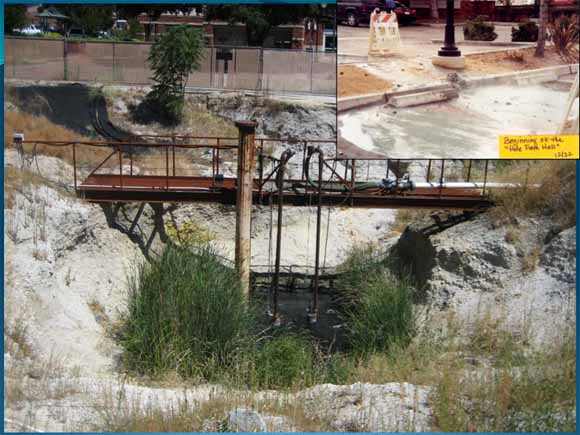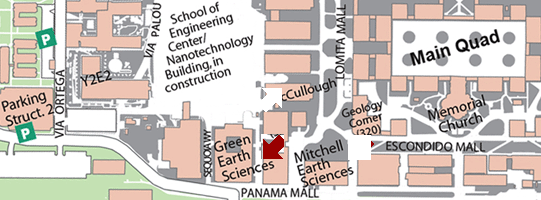
Presents
Location: Stanford University
This will be the 437th meeting since 1954

Beginning of the “Hole from Hell”
After the 2003 M6.5 San Simeon earthquake, several new hot springs developed along the Rinconada fault that bounds the west side of the Paso Robles Groundwater Basin (PRGB). Aeromagnetic anomalies delineate the boundaries of the basin and thickness of basin fill. The largest hot spring developed in a parking lot in the city center of Paso Robles. Other hot springs developed in front of the Paso Robles McDonalds and along Highway 101. The large pit that was constructed to attempt to manage the hot spring in the city center created a hazard—on days with no wind, CH4, N2, CO2, and H2S gases accumulated to potentially lethal levels, while sulfuric acid derived from oxidation of H2S was corroding iron and copper trim on nearby historic buildings. A cover was designed and constructed that collected the hot spring gases and water. The water was piped 1 km to a leach field on the Salinas River floodplain, and the restored parking lot allowed cars to park on top of the hot spring. The low temperature (<40°C) geothermal reservoir is present in the base of the Paso Robles Formation and the upper part of the Miocene Monterey Formation. Precipitates of sulfur, barite and FeS occur in the hot spring pools.
Demands from both population growth and agriculture have made water quality and availability a continuing concern. To address depletion of groundwater, a 25 km pipe was recently constructed to bring water from Lake Nacimiento to supplement municipal water supplies. The main aquifer in the PRGB is in the Pliocene Paso Robles Formation and a shallow alluvial aquifer that is recharged by the Salinas River and with water pumped from Lake Nacimiento.
Geochemical and isotopic data from hot spring waters and Paso Robles city water wells indicate that two water sources affect water quality and availability: meteoric water stored in Recent to Pliocene formations, and geothermal waters present in the deeper Monterey Formation. Geothermal waters and groundwater mix in the PRGB, resulting in distinct changes in chemistry and quality of water derived from wells that extend into the lower part of the Paso Robles Formation. Waters collected across the PRGB for this study plot on a two-end member mixing line defined by light stable isotopes (δ2H, δ18O, and 13C) and conservative elements (B, Cl, Na, Li). Most hot spring waters and well waters are a mixture of the two end members, indicating that well waters include a component of geothermal water. 13C ratios in the geothermal water end-members indicate that these older waters have a component of magmatic or mantle-sourced carbon.
In water wells that contain less than 15% geothermal water, water quality is acceptable. Water wells that contain from 15% to 50% geothermal water can have high Fe, Mn, and NH4 and require treatment. Water wells that have >50% geothermal water have high H2S and are unpotable. On the east side of the basin, water wells west of the San Juan and Red Hills faults have high levels of Cl, B, and Na, similar in chemistry to the Paso Robles geothermal system but these waters are not thermal. Waters from the geothermal reservoir could be used to substantially increase municipal water availability, as long as water production was managed to limit the amount of mixing to <50%.

Jim Rytuba
Jim Rytuba received his B.A. in Geology in 1968 from Amherst College, and his Ph.D. in Geology in 1975 from Stanford University. After starting a gold mineral exploration program for Chevron Oil Co., he joined the U.S. Geological Survey, Menlo Park, Calif. in 1975 where he continues to work. He is a research geologist and chief of the project on unconventional REE resources in high sulfidation systems. He also conducts research of the environmental impact of historic mercury mining in California. In the past three year his research has included a study of the Paso Robles geothermal system and groundwater in collaboration with Vicki Langenheim and Daniel Goldstein.
Reservations: The preferred way to make reservations is simply to email Mike Diggles at mdiggles@usgs.gov by Feb. 10, tell him you will attend, commit to pay, and bring your payment to the meeting. Mike always emails a confirmation; if you don’t get one, assume email crashed yet again and email him a second time. A check made to “PGS” is preferred, payable at the meeting.
If you want to pay in advance:
Everyone (including Stanford folks now) Please make dinner reservations by Feb. 10. Contact Mike Diggles, at U.S. Geological Survey, 345 Middlefield Road, MS-951 Menlo Park, CA 94025, Tel.: (650) 329-5404. Send check made out to “PGS” to Mike.
Dinner and the social hour is $35.00; this includes $5 that we use to help pay for students who are only $8.00 (also partially subsidized thanks to the School of Earth Sciences, Stanford University (Note, no-show reservations owe the full price).
Doris, whose wonderful crew prepares our meals, asked that we let you know that people who are late RSVPing and people who show up without a reservation will be welcome but that they will be eating on paper plates with plastic utensils (food supply permitting).
Dues for Academic Year 2012-2013 ($10.00) should be sent to Mike Diggles, U.S. Geological Survey, 345 Middlefield Road, MS-951, Menlo Park, CA 94025. Mike’s phone: (650) 329-5404.
Officers: Joe Colgan, President; Mike Diggles, Secretary-Treasurer; Elizabeth Miller, PGS Stanford University Coordinator

Date created: January 17, 2013
Last modified: January 17, 2013
Created by: Mike Diggles, Webmaster-Secretary-Treasurer, PGS.